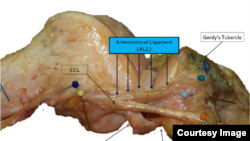Scientists have discovered a new human body part.
Knee surgeons at the University of Leuven in Belgium described, for the first time, a previously unknown ligament in the knee. The anterolateral ligament (ALL) appears to play an important role in patients with anterior cruciate ligament (ACL) tears.
Specifically, many patients who tear their ACL continue to have problems even after corrective surgery. Patients with ACL-repaired knees continue to experience so-called 'pivot shift', or episodes where the knee 'gives way' during activity. ACL injuries are common among athletes in pivot-heavy sports such as soccer, basketball, skiing and football.
The existence of the ALL was suggested by a French surgeon in 1879, who thought there might be an additional ligament located on the anterior of the knee.
For the last four years, orthopaedic surgeons Dr. Steven Claes and Professor Dr, Johan Bellemans have been conducting research to see if the ligament described could play a role in continued knee problems after an ACL repair.
The two doctors used cadavers to confirm the existence of the ALL, which was present in all but one of the 41 cadavers examined.
Knee surgeons at the University of Leuven in Belgium described, for the first time, a previously unknown ligament in the knee. The anterolateral ligament (ALL) appears to play an important role in patients with anterior cruciate ligament (ACL) tears.
Specifically, many patients who tear their ACL continue to have problems even after corrective surgery. Patients with ACL-repaired knees continue to experience so-called 'pivot shift', or episodes where the knee 'gives way' during activity. ACL injuries are common among athletes in pivot-heavy sports such as soccer, basketball, skiing and football.
The existence of the ALL was suggested by a French surgeon in 1879, who thought there might be an additional ligament located on the anterior of the knee.
For the last four years, orthopaedic surgeons Dr. Steven Claes and Professor Dr, Johan Bellemans have been conducting research to see if the ligament described could play a role in continued knee problems after an ACL repair.
The two doctors used cadavers to confirm the existence of the ALL, which was present in all but one of the 41 cadavers examined.








